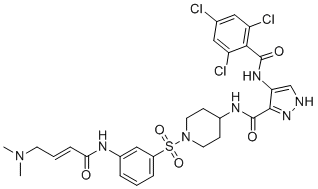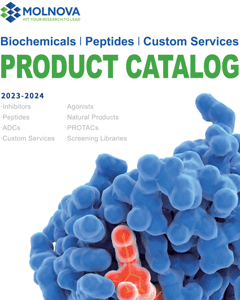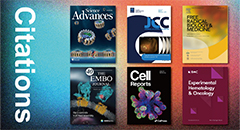
FMF-04-159-2
CAS No. ——
FMF-04-159-2( —— )
Catalog No. M16940 CAS No. ——
FMF-04-159-2 is a potent, selective, covalent CDK14 inhibitor (IC50=86 nM) with pan-TAIRE family specificity (CDKs 14-18).
Purity : >98% (HPLC)
 COA
COA
 Datasheet
Datasheet
 HNMR
HNMR
 HPLC
HPLC
 MSDS
MSDS
 Handing Instructions
Handing Instructions
| Size | Price / USD | Stock | Quantity |
| 100MG | Get Quote | Get Quote |


|
| 200MG | Get Quote | Get Quote |


|
| 500MG | Get Quote | Get Quote |


|
| 1G | Get Quote | Get Quote |


|
Biological Information
-
Product NameFMF-04-159-2
-
NoteResearch use only, not for human use.
-
Brief DescriptionFMF-04-159-2 is a potent, selective, covalent CDK14 inhibitor (IC50=86 nM) with pan-TAIRE family specificity (CDKs 14-18).
-
DescriptionFMF-04-159-2 is a potent, selective, covalent CDK14 inhibitor (IC50=86 nM) with pan-TAIRE family specificity (CDKs 14-18); potently inhibited the TAIRE kinases CDK14, CDK16, CDK17, and CDK18; CDK14 was potently engaged by FMF-04-159-2 (IC50=39.6 nM), and this engagement was sustained after a 2-h, compound washout (IC50=56.3 nM), indicates irreversible binding; FMF-04-159-2 is a valuable tool for study of CDK14 kinase function.
-
In Vitro——
-
In Vivo——
-
Synonyms——
-
PathwayAngiogenesis
-
TargetCDK
-
RecptorCDK
-
Research Area——
-
Indication——
Chemical Information
-
CAS Number——
-
Formula Weight683.002
-
Molecular FormulaC28H30Cl3N7O5S
-
Purity>98% (HPLC)
-
Solubility——
-
SMILES——
-
Chemical Name(E)-N-(1-((3-(4-(dimethylamino)but-2-enamido)phenyl)sulfonyl)piperidin-4-yl)-4-(2,4,6-trichlorobenzamido)-1H-pyrazole-3-carboxamide
Shipping & Storage Information
-
Storage(-20℃)
-
ShippingWith Ice Pack
-
Stability≥ 2 years
Reference
1. Ferguson FM, et al. Cell Chem Biol. 2019 Mar 11. pii: S2451-9456(19)30070-4.
molnova catalog



related products
-
Bohemine
Bohemine is a cyclin-dependent kinase inhibitor.
-
CDK9-IN-2
CDK9-IN-2 is a potent and selective CDK9 inhibitor with IC50 of <8 nM, example 4 in patent WO2011026917A1.
-
CGP-74514A hydrochlo...
CGP-74514A hydrochloride is a potent CDK1 inhibitor with IC50 of 25 nM; induces caspase-9 activation and PARP degradation, mediates apoptosis in U937 cells.



 Cart
Cart
 sales@molnova.com
sales@molnova.com


